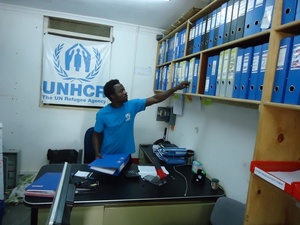More than 10,000 Congolese civilians flee to Uganda to escape fighting in North Kivu
More than 10,000 Congolese civilians flee to Uganda to escape fighting in North Kivu

New arrivals in Uganda today at the Bunagana crossing point.
KAMPALA, Uganda, October 30 (UNHCR) - The latest fighting in eastern Democratic Republic of the Congo (DRC) has pushed rebel fighters out of several strongholds as well as forcing more than 10,000 people to seek safety in Uganda.
The fighting pitting government and UN troops against M23 rebel forces in North Kivu province began last Friday. Refugees began crossing into southern Uganda's Kisoro district, via the border town of Bunagana, on Monday.
Since then, more than 10,000 people have crossed through Bunagana, including 8,000 on Wednesday, according to UNHCR figures. News reports said the government had captured Bunagana today, but aid workers heard sound of gunfire and explosions before leaving the border area for security reasons and before an air attack left people injured inside Uganda.
So far, two refugees are confirmed to have been injured and a Medical Teams International ambulance was sent on Wednesday to the border to collect them and assess the situation. Before this, UNHCR staff estimated that around 3,000 people had returned to North Kivu with encouragement from government troops.
The latest fighting in North Kivu also forced some 2,500 people to seek shelter in Rwanda, according to the government there, but most appear to have returned.
In Uganda's Kisoro district, UNHCR has since Monday arranged for more than 2,940 people to be transported from the border area to a transit centre at Nyakabande, some 20 kilometres from Bunagana. Many others are camped in open spaces or living on verandahs as UNHCR works to transport them to Nyakabande before the rains resume.
There are also around 400 people camped at Kanobe, an unofficial border crossing inaccessible by road. The refugee agency is working with border security officials to reach them and bring them to the Nyakabande Transit Centre, where they are provided with shelter, food and emergency aid. The transit centre has a maximum capacity of 30,000 people.
UNHCR has positioned supplies to support around 5,000 refugees with more being mobilized to help keep up with the rising numbers. UNHCR staff are also constructing two new communal shelters which will be able to accommodate an additional 300 people each.
In recent months, the number of new arrivals from North Kivu to Nyakabande had fallen to around 20 per day while peace negotiations were under way in Kampala between the DRC government and the M23, which comprises former soldiers who defected from the armed forces and took up arms in April last year. The M23 captured and briefly held the North Kivu capital, Goma, last November before peace talks started in December that year. But the government has gained ground this year with the help of a newly formed UN intervention brigade.
Meanwhile, UNHCR fears that resources at Nyakabande will face a severe strain if more people continue to cross the border. "One of our main concerns at the moment is water and sanitation,' said UNHCR Senior Field Coordinator Maureen McBrien. "This is one of the critical areas in any large influx like this. Currently we have enough latrines to support around 3,500 refugees so this is something we are working on as a priority to accommodate the new arrivals."
The majority of those arriving are women and children and most have fled from nearby areas, up to 15 kilometres from the border. Many have brought livestock, including goats and sheep, with them as they fled.
So far this year UNHCR has assisted around 50,000 Congolese arriving from DRC. In Uganda, Congolese refugees make up 65 per cent of the entire refugee population and the majority of these have arrived in the last three years.
Meanwhile, in a separate development in north-eastern DRC, some 4,000 to 6,000 refugees have crossed into Uganda's north-west region from DRC's Orientale province to escape from fighters of a new rebel group called M18. The rebels have reportedly been creating havoc, looting property, beating people who refuse to leave the Kakwa area, and even burned several villages to the ground.
In March, the M18 was in the news when their leader Colonel Eric Zachariah Ndosa was seized on Ugandan territory by unidentified assailants from the DRC, but intercepted by the Ugandan army before he was moved out of the country.
Last Sunday, UNHCR carried out a joint border monitoring mission with central government officials and Koboko district officials to determine the number of arrivals. These are being registered by district officials and are being transported to a nearby youth centre outside Koboko town. They will be transferred to the Rhino Camp settlement in Arua district - some 105 kilometres away - which until now has been receiving South Sudanese refugees.
By Lucy Beck in Kampala, Uganda












